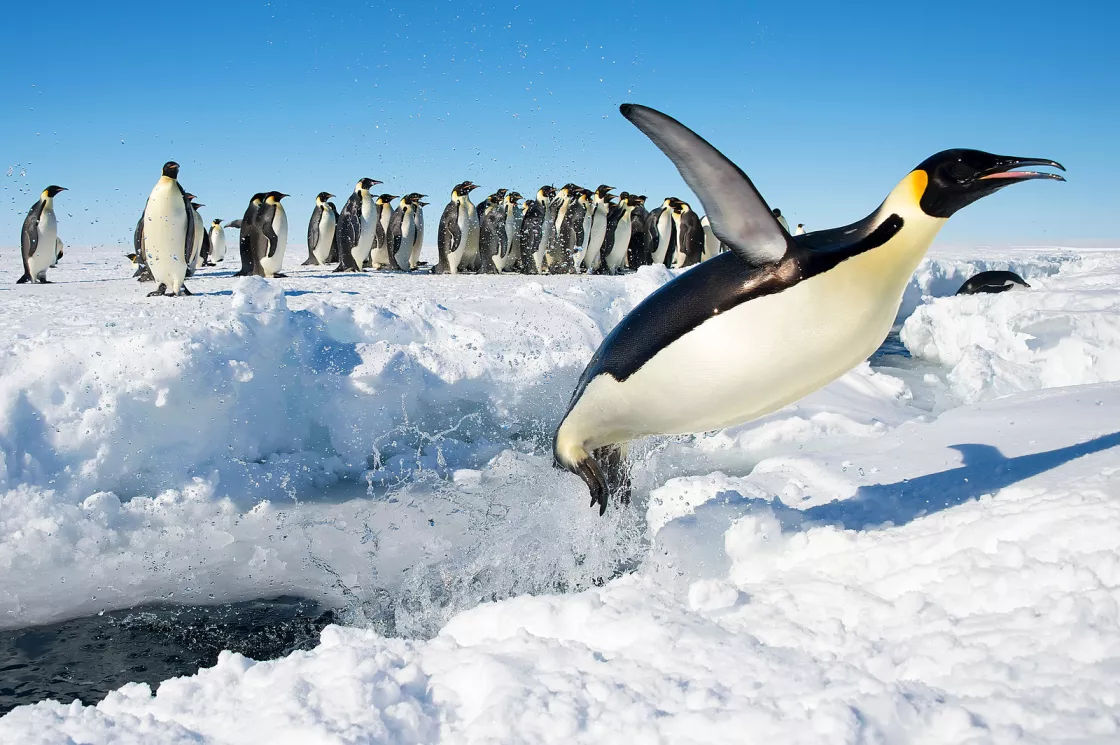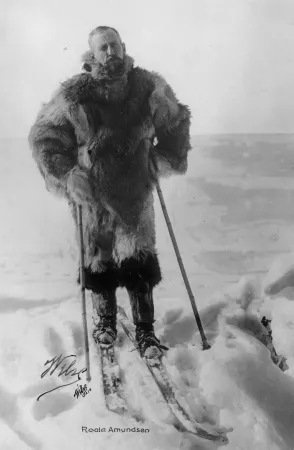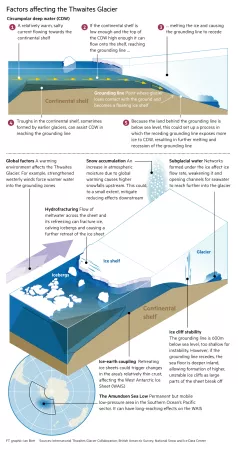Ice Shelves
Why they matter
Because ice shelves are exposed to both the air above and the ocean below, ice shelves respond more quickly than ice sheets or glaciers to rising temperatures. Ice shelves do not contribute directly to sea level rise when they break up because they are already floating on water. However, ice shelf collapse contributes to sea level rise indirectly because the glaciers that flow into the ice shelf accelerate.
Ice streams and glaciers constantly push on ice shelves on their upstream side. As the large plates of ice spread over the ocean, many shelves come up against coastal features such as islands, peninsulas, or submerged mountains, creating a resisting pressure that slows their movement toward the ocean. If an ice shelf collapses, this backpressure disappears. The brakes on glacier flow are released. The glaciers that fed into the ice shelf speed up, flowing more quickly out to sea. Glaciers and ice sheets rest on land, so once they flow into the ocean, they contribute to sea level rise.
Research suggests that glaciers behind ice shelves may accelerate by as much as five times following a rapid ice shelf retreat. To read about a 2004 study on such glacial acceleration, see Antarctic Glaciers Accelerate in Wake of Ice Shelf Breakup.
Ice shelves and wildlife
Just as with sea ice, ice shelves are breeding grounds for algae which sustain krill, small shrimp-like creatures that feed larger animals like whales, seals, and penguins.
In Antarctica, penguins also depend on ice shelves for safety and breeding. Emperor penguins, the largest of the penguin species, can stand as tall as 1.22 meters (4 feet) and weigh up to 41 kilograms (90 pounds). These penguins breed on sea ice, moving to ice shelves for safety as sea ice retreats. When emperor chicks hatch, they must wait about a year for their gray, fluffy coat to turn into an impenetrable suit of waterproof feathers. Otherwise, they will drown. In 2016, in Halley Bay, Antarctica’s second-largest colony of emperor penguins was devastated after an intense storm broke up the sea ice before the chicks matured. More than 10,000 chicks vanished, and the colony has yet to recover.
Researchers have found that the underside of the ice shelf can also be a refuge for wildlife. Several coastal ice shelves have been colonized by small worms and sea anemones that feed on particles in the water. When alarmed or threatened, they retreat into their icy holes in the shelf.
In late December 2010, a new species of small sea anemone was discovered burrowed into Antarctica’s Ross Ice Shelf. A camera-equipped robot surveyed the underside of the shelf, finding thousands upon thousands of these small anemones—the first reported to live in the ice. Anemones, named after a flower, are predatory marine animals distantly related to corals and jellyfish. Unlike other sea anemones that live on or in the sea floor, these tiny, white invertebrates live upside down, clinging to the ice shelf, and extending their tentacles to filter feed. During this discovery, scientists also saw fish routinely swim upside down, using the ice shelf as the floor of their submarine world. Other life was also found: polychaete worms, amphipods, and a bizarre little creature dubbed the egg roll—10 centimeters (4 inches) long and 2.5 centimeters (1 inch) round, this cylindrical creature swims using appendages at both ends of its body.
The 2010 discovery of the new species, Edwardsiella andrillae, initially raised more questions than answers. Scientists had no idea how these anemones dug into the ice—strategies used by other anemones would not work there. Though the underside of the ice shelf was littered with life, signaling strong proliferation, scientists did not know how they reproduced or what they ate.
Ice shelves cover roughly a third of Antarctica's continental shelf, the portion of the continent that is submerged, having a relatively shallow depth compared to the open ocean. The seafloor beneath the floating ice shelves have generally been thought to be barren, especially further inland, away from the edge of the ice shelf. In pitch blackness and hundreds of miles away from the coast, new observations from two boreholes in the Filchner-Ronne Ice Shelf challenge previous assumptions on life far beneath these ice shelves. This recent observation found filter feeding organisms on a boulder 260 kilometers (162 miles) inland from the ice front, and somewhere between 625 and 1,500 kilometers (388 to 930 miles) from the nearest region of photosynthesis. Research of this newly discovered ecosystem continues.
Ice shelves and people
Many of the first areas to be explored in Antarctica were ice shelves. Two early polar explorers, the Norwegian Roald Amundsen and the British Robert Scott, had to cross the gigantic Ross Ice Shelf before their first attempts to reach the South Pole. Several early bases were built on ice shelves, such as a series of US bases called Little America from 1929 to 1958 and the UK base Halley. However, building a base on an ice shelf is risky because of the possibility of a large iceberg breaking away from the shelf and carrying the base with it—a process called calving.
The main impact ice shelves have on people is their potential to indirectly raise sea levels. Ice streams and glaciers constantly push on ice shelves on their upstream side. As the large plates of ice spread over the ocean, many shelves come up against physical resistance in the form of coastal features such as islands, peninsulas, or submerged mountains. If an ice shelf collapses, this support disappears and the glacier that feeds into the ice shelf is free to flow faster. Glaciers and ice sheets rest on land, so once they flow into the ocean, they contribute to sea level rise.
In the United States, almost 40 percent of the population lives in coastal areas that are considered high density in population, and where sea level plays a role in flooding, shoreline erosion, and hazards from storms. More than 600 million people, or about 10 percent of the world’s population, live in coastal areas that are less than 10 meters (33 feet) above sea level. Nearly 2.4 billion people, or about 40 percent of the world’s population, live within 100 kilometers (60 miles) of the coast. To learn more about sea level rise, read about the impacts of climate change on ice shelves.
Impacts of climate change on ice shelves
Since the 1990s, scientists have observed a series of unexpected ice shelf collapses on the Antarctic Peninsula, during which huge areas of the ice shelf fall apart within days or weeks. Although it is not unusual for ice shelves to calve large icebergs, that process normally takes months to years, as cracks slowly form in the ice. Following a calving, ice shelves generally recover over a period of decades. However, this process, known as ice shelf disintegration, happens much faster, although it requires decades of slowly warming climate conditions.
Since the 1950s, the Antarctic Peninsula has been one of the most rapidly warming parts of the planet, with air temperature increases of 3 °C (5.4 °F). This is five times the average rate of global warming as reported by the Intergovernmental Panel on Climate Change (IPCC).
Since the 2000s, several ice shelves on the Antarctic Peninsula and along the northern coast of Canada have experienced rapid break up or disintegration. In 1995 and again in 2002, large areas of the Larsen Ice Shelf (the A and B sectors) broke apart within weeks, losing 1,000 square kilometers (390 square miles) and over 3,000 square kilometers (1,200 square miles), respectively. In March 2008, after the same disintegration process, Antarctica’s Wilkins Ice Shelf retreated by more than 400 square kilometers (160 square miles). Later that summer, several ice shelves along Ellesmere Island in Northern Canada broke up in a matter of days.
For more information on extensive ice shelf collapses in Antarctica, read What broke up the Wilkins Ice Shelf? and What happened to the Larsen Ice Shelf?
Implications of ice shelf collapse
The Larsen B Ice Shelf on the Antarctic Peninsula was a glacier-fed shelf, and after its disintegration, the glaciers feeding it accelerated. If all of those glaciers were to flow into the ocean, they would raise ocean level by only a few millimeters. Greenland's glaciers and those feeding the Ross or Ronne ice shelves, however, would have a more significant effect.
The Transantarctic Mountains divide Antarctica into two sections: East and West Antarctica—indicating regions that lie mostly in the Eastern or Western Hemisphere, respectively. Though research has shown that climate change has impacted both sides, the West Antarctic Ice Sheet (WAIS) is of particular concern because its underlying bedrock rests far below sea level, making it potentially unstable. According to the 2019 Intergovernmental Panel on Climate Change (IPCC) Special Report on the Ocean and Cryosphere in a Changing Climate, the WAIS contains enough ice to raise global sea level by 3.4 meters (11.2 feet). In 2021, the IPCC put out the sixth assessment report, confirming that mass losses from West Antarctic outlet glaciers outpace mass gain from snow accumulation. The main cause of mass loss is ice shelf basal melt, where warming ocean temperatures undercut the ice shelf. The 2021 IPCC report also stated if global temperatures warm between 2 °C (4 °F) and 3 °C (5 °F), the WAIS will be lost almost completely in the next few millennia.
The Ross Ice Shelf is the largest ice shelf in Antarctica, about the size of Texas or France. It serves as a main outlet for several major glaciers from the WAIS. The average annual air temperature of the Ross Ice Shelf is well below freezing, and summer temperatures in the warmest part of this shelf (the northwest corner) are currently several degrees too cool for the formation of melt ponds. Although there has been some warming of the Ross Ice Shelf region in recent years, surface melting there is still a rare occurrence.
The Thwaites Ice Shelf lies in the Amundsen Sea, and is one of the biggest ice shelves in West Antarctica. Since the 1980s, it has become increasingly unstable. Thwaites and Pine Island Glaciers flow into Pine Island Bay and out onto the ice self, draining the WAIS. Both of these glaciers have grounding lines, the point where the outflowing ice begins to float, that lie on sloping bedrock inland toward the continent. This configuration is potentially unstable: a small amount of thinning of the ice at the grounding line causes it to retreat a long distance towards the interior. Moreover, as the line of flotation retreats, the ice becomes thicker, driving the ice to flow faster and thin more rapidly. Thwaites Glacier is particularly important because it extends into the interior of the WAIS. By itself, the loss of Thwaites Glacier would contribute about 0.6 meters (2 feet) to global sea level rise. But its central location within the WAIS means that as it retreats, it will also destabilize the rest of the WAIS. Unlike the Antarctic Peninsula, air temperatures appear not to be the main source of thinning, but rather the intrusion of warm, deep ocean water that is tipping the balance of the ice shelf into retreat.
The Thwaites and Pine Island Glaciers would only need to retreat a short distance further before an accelerated retreat would begin.
As the ice front retreats to the thicker ice in the interior of the WAIS, calving at the ice front can create increasingly tall ice cliffs. However, ice is structurally weak, far weaker than rock, which can support canyons and cliffs up to a few thousand feet tall. For ice, a cliff higher than about 100 to 120 meters (330 to 400 feet) tall is unstable and quickly collapses. Under the right conditions, this collapse results in a runaway process where new cliffs form behind the previous ice front, which then are unstable and collapse, retreating inland rapidly. A study has shown that Antarctica may have experienced such a rapid retreat driven by these cliff collapses about 12,300 years ago.



